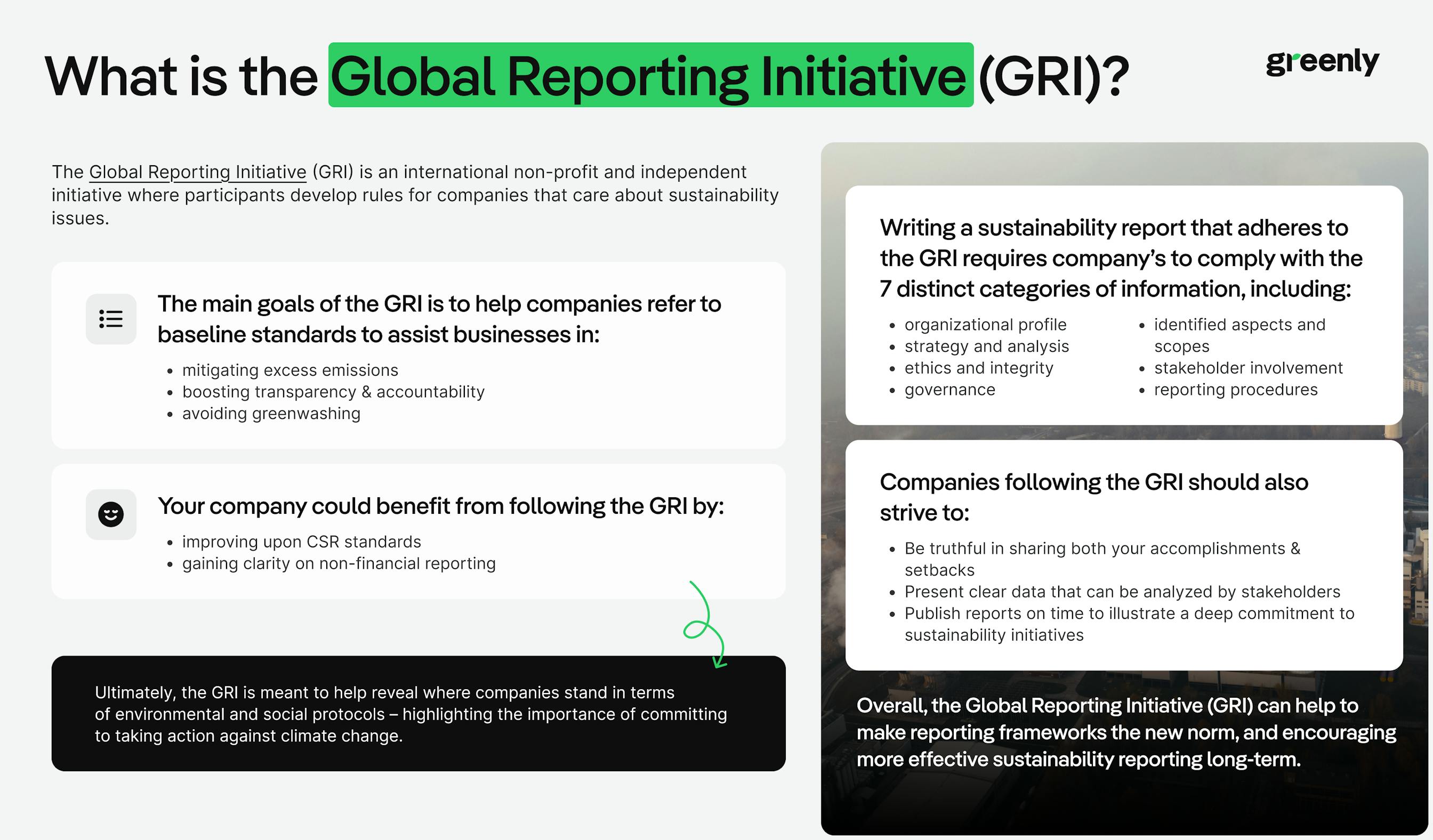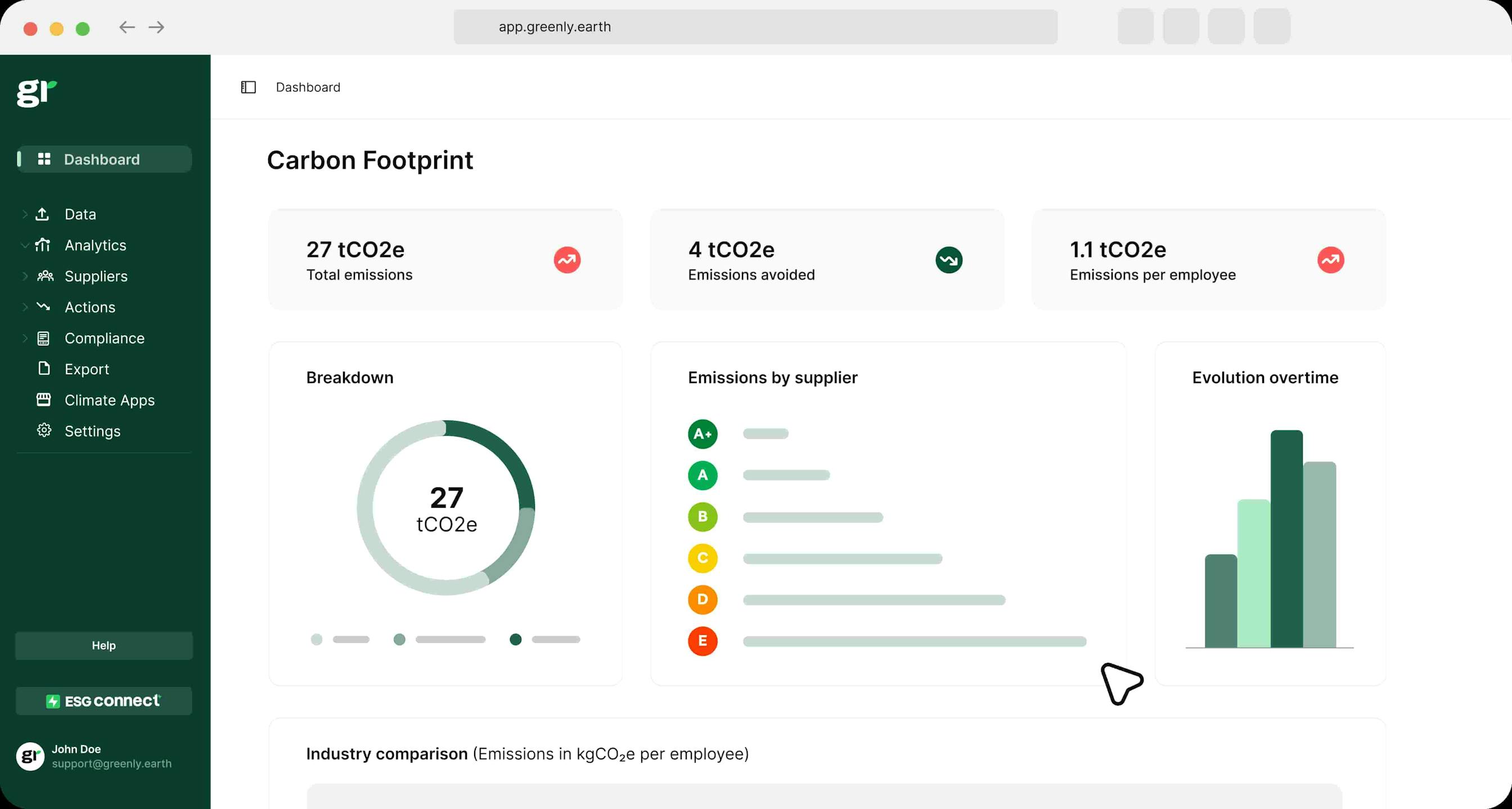
California Climate Accountability Package: SB253, SB261, & SB252
What is the California Climate Accountability Package, and how do SB 253 and SB 261 (SB 219), and SB 252 help the state work towards their environmental goals?
ESG / CSR
Industries



For companies, transparency is essential to gain the trust of stakeholders. Whether it's to reinforce its employer brand, health and safety impacts, significant waste related impacts, create local community engagement, complying with a legal form, reducing energy consumption, or to maintain its relationship with its customers – the issues surrounding sustainable development are increasingly present.
In order to do so with sincerity and clarity, nothing is better than to rely on defined indicators and a structured methodology. This is where the Global Reporting Initiative's reference framework, also known as GRI G4, comes in.
The Global Reporting Initiative is a reference tool with guidelines for measuring the involvement of companies in the issue of sustainable development, but it is not mandatory.
👉 In this article, we'll provide an overview of the Global Reporting Initiative, which companies are concerned, and how GRI can help to promote environmentally responsible economies.
💡 The Global Reporting Initiative (GRI) is an international non-profit and independent initiative where many participants develop rules for companies that care about sustainability issues.
Therefore, engaging in GRI reporting framework is most suitable for companies that wish to be as transparent as possible, mitigate their negative environmental impact, avoid greenwashing, and use GRI sector standards to provide various sustainability indicators.
There are numerous actors involved in the development of GRI universal standards which include the following:
👉 These guidelines allow companies to report their economic impacts, social and environmental dimensions of their activities, products and services following a specific methodology, and any other additional information reported that can help to improve a company's transparency and accountability.
The table below will explain all of the requirements for companies that choose to conduct their sustainability reporting under the GRI framework.
| Aspect | Global Reporting Initiative (GRI) Framework | Requirements for Companies |
|---|---|---|
| Purpose | The GRI framework provides a standardized approach for organizations to report on their economic, environmental, and social impacts. | Companies must disclose relevant information on sustainability performance based on the GRI Standards, allowing stakeholders to assess their environmental and social impacts. |
| Structure | GRI Standards are organized into three series: **Universal Standards**, **Topic-Specific Standards**, and **Sector Standards**. These cover broad reporting requirements and specific sustainability topics like climate change, human rights, and labor practices. | Organizations must select the most relevant standards to their operations and ensure their reports adhere to the guidelines set in the Universal and Topic-Specific Standards, based on material issues. |
| Materiality | Materiality is central to GRI reporting, meaning organizations must focus on topics that reflect their significant economic, environmental, and social impacts. | Companies are required to conduct a **materiality assessment** to identify and prioritize the sustainability topics that are most relevant to their business and stakeholders. |
| Reporting Principles | GRI uses principles such as **accuracy**, **balance**, **clarity**, **comparability**, **reliability**, and **timeliness** to guide the reporting process. | Organizations need to ensure that their reports are transparent, accurate, and reflect both positive and negative impacts in a balanced manner. Comparability and consistency in data presentation are essential. |
| Stakeholder Inclusiveness | The GRI framework emphasizes engaging with stakeholders to understand their concerns and expectations regarding sustainability practices. | Companies must demonstrate **stakeholder engagement** and consider their input when determining material issues and reporting on sustainability topics. |
| Reporting Formats | Reports can be based on GRI's **Core** or **Comprehensive** formats. The Core option requires fewer disclosures, while the Comprehensive format provides more in-depth reporting. | Companies can choose the **Core** or **Comprehensive** reporting format depending on the depth of information they wish to disclose. Both formats require transparency and adherence to GRI standards. |
| Third-Party Assurance | Third-party assurance of sustainability reports is recommended to enhance credibility and trust in the information disclosed. | While not mandatory, companies are encouraged to seek **external assurance** of their sustainability reports to verify the accuracy and reliability of the data presented. |
| Continuous Improvement | GRI encourages organizations to use their sustainability reports as tools for continuous improvement and accountability in their sustainability journey. | Companies are expected to use the insights from their reports to improve their sustainability strategies and track progress over time. |



💡 The main goal of a reporting organization such as reporting standards required under GRI reporting is to reveal where companies stand on environmental and social issues.
The Global Reporting Initiative highlights the concrete and committed actions that have been put in place to reduce the, at times harmful, environmental and societal impact created by companies. The defined guidelines under the GRI reporting framework make it possible to measure the performance of these various actions taken by companies to improve their current method of impact reporting.

The Global Reporting Initiative was created in 1997 in the United States from the merger of CERES (Coalition for Environmental Responsible Economies) and UNEP (United Nations Environment Programme).
The Global Sustainability Standards Board (GSSB) is the entity responsible for reviewing current GRI standards in addition to assisting in the development of future standards to ensure optimal sustainability reporting and sustainability performance.
💡 In the United States, the Sustainability Accounting Standards Board (SASB) or Business for Social Responsibility (BSR) would work to help implement GRI standards.
Since 1997, there have been many steps towards the development of the GRI we know as of today:
Today, these GRI G4s are based on 69 indicators that are broken down into two levels according to their degree of importance:
All these indicators are based on 6 different areas:
👉 Overall, these global standards can help to make these recognized frameworks the new norm to promote even more general disclosures and transparency regarding corporate activities and their potential negative impacts.
GRI standards provide an easy way for organizations to measure their ESG impacts, report material topics, and other positive change contributed by specific sectors.
💡 In addition to gaining a better perspective on the actions taken to reduce negative environmental and social impacts, reporting with a GRI content index allows for a more in-depth comparative vision to allow stakeholders, consumers, and even employees to become more aware of the impact of current business endeavors.
In the US, the Securities and Exchange Commission (SEC) is working on a new rule that would require public companies to disclose their impact on the environment, and the impact that climate changes might have on their operations and profitability.
For instance, GRI standards could help to improve sustainability reporting and transition assistance programs for upgrading employee skills. Companies could avoid unwanted attention from governance bodies and understand significant risk associated with failing to create transparency.
In light of the announcements concerning the ecological stakes of the next few years, it is highly likely that these measures, which encourage companies that play the commitment card, will be reinforced.
Companies that choose to engage in a CSR policy with ambitious objectives will often find it's best to base your KPIs on clear and relevant guidelines.
👉 The GRI G4, commonly used in the European Union in conjunction with European Sustainability Reporting Standards (ESRS), is an additional tool to measure performance and actions to see the impact of the CSR approach.
As it is based on 69 criteria and scans 6 different areas, this extensive framework for sustainability reporting can be used to define precise and ambitious ecological objectives, while avoiding the 4 pitfalls that hinder effective CSR.
Using the Global Reporting Initiative to create your CSR strategy gives you the advantage of having a surefire and innovative approach focused on economic, environmental and social performance.
💡 The CSR reports are carried out in a standard form following a methodology based on the GRI G4
Non-financial reporting has been a regular feature of business practices for several years now, and thanks to the Global Reporting Initiative – 5,800 companies have engaged in sustainability reporting and published sustainability report under GRI standards.
The GRI guidelines and indicators formalize the method used to make a credible and reliable extra-financial performance declaration. This is not quite the same as CSR because the EPR allows investors to finance projects that are in line with their values.
Following the Global Reporting Initiative indicators to build your Corporate Social Responsibility policy, in addition to gaining clarity in your objectives and having precise KPIs, is a good thing if you want to label your CSR approach.
For example, EcoVadis evaluates the actions implemented in its CSR and analyzes the related performances.
This evaluation is based on 4 distinct themes:
These 4 themes are drawn from various international CSR standards:
👉 By following the G4 guidelines, a company that follows a specific CSR approach has a better chance of obtaining the appropriate label and certification.

💡 The best way is to create a team dedicated to the environmental and CSR issues of your company and then train them on CSR issues by integrating the GRI principles.
It is essential to train both full time employees and part time employees in the importance of managing economic activities, customer health, and supply chain resilience. GRI reporting will be most successful with this type of management approach.
Understanding the issues and problems behind certain actions is a real way to raise awareness and truly engage your employees. Through this, everyone will contribute to positive change while also finding more meaning in their work. It's a win-win!
In order to implement the GRI guidelines in your CSR approach, there is a methodology to follow in the framework of your company's CSR reports.
Two basic principles must be respected:
👉 The GRI Implementation Guide explains that these principles are the ones that will guide the decision making regarding the content to be covered in the report while examining the activities and impacts of the organization – in addition to the expectations and real interests of its various stakeholders.
Defining its content principles allows for the following:
However, it is important to note that the quality principles vary from the content principles depicted under GRI standards.
👉 The GRI Implementation Guide states that these principles help inform choices about the quality of the information provided in the report, including its presentation. Good quality information is fundamental to the ability of stakeholder groups to accurately and legitimately assess the organization's performance and take appropriate action.
Clearly defining quality principles allows you to:
Once all the information has been collected and analyzed, it is advisable to complete a table based on the GRI standards reference table to ensure proper formatting.
A report that complies with the Global Reporting Initiative standards must include the 7 distinct categories of information that are divided into subcategories:
There are 3 specific subcategories within each of these broad categories:
This information should be filled in in a table that should have several well-defined boxes:
Once all of this is completed, your organization will have successfully completed their GRI standards reference table!
💡 Remember that 84% of the world's largest companies apply the GRI guidelines in their sustainable development approach. The Global Reporting Initiative's indicators are true global references, making it possible to measure the performance and impact of the actions implemented.

If reading this article about the Global Reporting Initiative (GRI) has made you interested in reducing your carbon emissions to further fight against climate change – Greenly can help you!
Making an effort to switch your company over to the values of a green business can be overwhelming, but don’t worry – Greenly is here to help. Click here to schedule a demo to see how Greenly can help you find ways to improve energy efficiency and decrease the dependency on fossil fuels in your own company.
Greenly can help you make an environmental change for the better, starting with a carbon footprint assessment to know how much carbon emissions your company produces.
Click here to learn more about Greenly and how we can help you reduce your carbon footprint.
